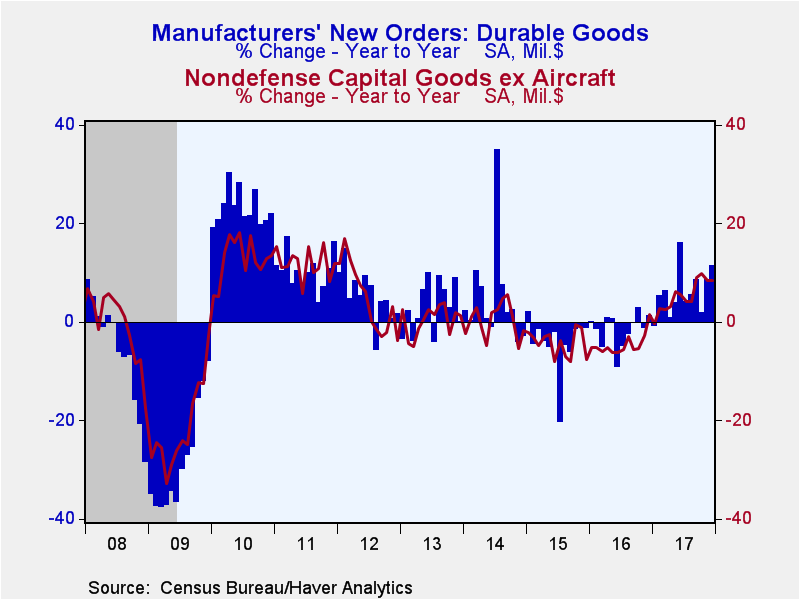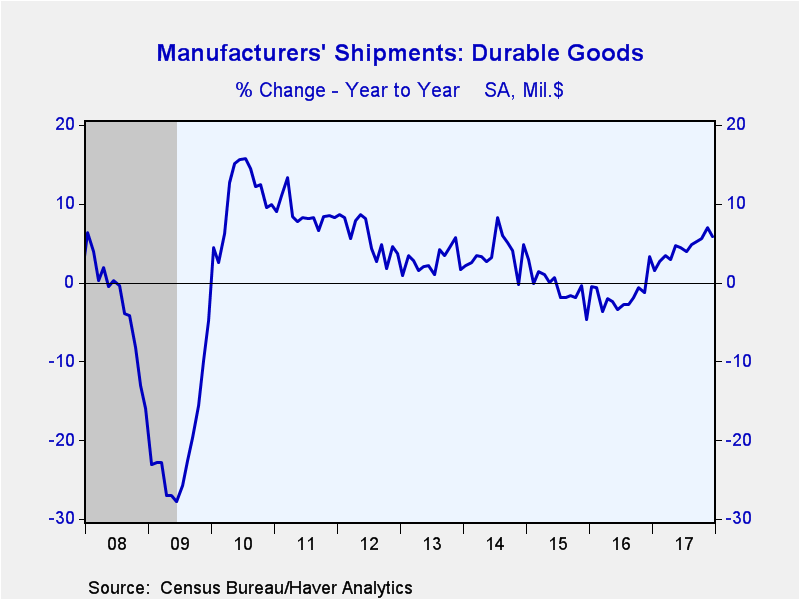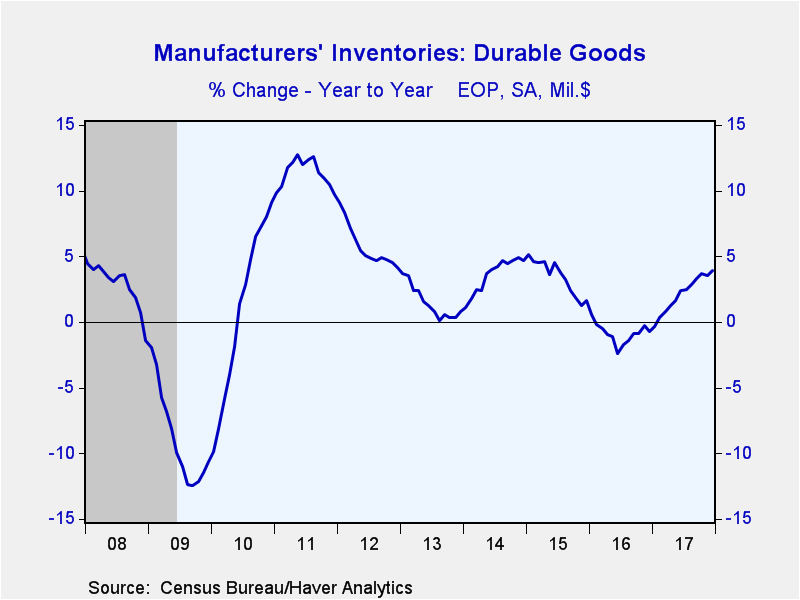 Global| Jan 26 2018
Global| Jan 26 2018U.S. Durable Goods Orders Soared in December Propelled Again by Aircraft
by:Sandy Batten
|in:Economy in Brief
Summary
New orders for durable goods soared 2.9% m/m (11.5% y/y) in December on top of an upwardly revised 1.7% m/m gain in November (initially reported as +1.3%). The Action Economics Forecast Survey had anticipated a 0.9% m/m increase. For [...]
New orders for durable goods soared 2.9% m/m (11.5% y/y) in December on top of an upwardly revised 1.7% m/m gain in November (initially reported as +1.3%). The Action Economics Forecast Survey had anticipated a 0.9% m/m increase. For all of 2017, orders were up 5.9% from 2016 versus a 1.7% decline in 2016. This was the first annual increase in orders since 2014 and the largest since 2011.
The transportation sector (notably aircraft) was again the prime mover in December. Orders for transportation equipment were up 7.4% m/m (18.2% y/y) in December on top of an upwardly revised 4.6% m/m rise in November. Orders for aircraft and parts jumped up 24.4% m/m in December after an 11.6% m/m rise in November. Excluding transportation orders, the rest were up a modest 0.6% m/m (8.2% y/y) in December versus an upwardly revised 0.3% m/m gain in November. The December rise in ex-transportation orders was in line with market expectations. For all of 2017, ex-transportation orders were up 6.5% from 2016, their first increase since 2014 and the largest since 2011.
While nondefense aircraft orders were strong in December, the lion's share of the monthly increase in all aircraft was in defense. As a result, nondefense capital goods did not enjoy the entire aircraft surge and fell 0.1% m/m (16.4% y/y) in December following a 2.3% m/m jump in November. Even with this December softness, nondefense capital goods orders were up 7.9% in 2017 after having declined in each of the previous two years. Nondefense orders excluding aircraft slid 0.3% m/m (8.4% y/y) in December with an upward revision to November, and were up 5.3% for all of 2017.
Shipments of durable goods rose 0.6% m/m (5.8% y/y) in December, down from their upwardly revised 1.3% m/m gain in November. For all of 2017, shipments increased 4.4%, their first annual rise since 2014. Shipments of capital goods excluding aircraft (a key real time indicator of nonresidential investment in equipment) was up 0.6% m/m (8.4% y/y) in December with a meaningful upward revision to November (+0.3% m/m versus the initially reported -0.1% m/m). This put the December reading for this indicator well above the fourth quarter average, providing a solid starting point to the first quarter of 2018. Business spending on equipment has been on a tear in the last half of 2017--the Q4 2017 GDP report also released this morning showed an 11.4% q/q (AR) increase in business spending on equipment on top of a 10.8% q/q (AR) gain in Q3.
Unfilled orders for durable goods rose a solid 0.6% m/m (1.9% y/y) in December following a 0.1% m/m rise in November. For all of 2017, unfilled orders gained 1.9%, their first annual gain in three years. Durable goods inventories increased 0.3% m/m (3.9% y/y) in December, their largest increase in three months. For all of 2017, durables inventories rose 3.9%.
The durable goods figures are available in Haver's USECON database. The Action Economics consensus forecast figure is in the AS1REPNA database.
| Durable Goods NAICS Classification | Dec | Nov | Oct | Dec Y/Y | 2017 | 2016 | 2015 |
|---|---|---|---|---|---|---|---|
| New Orders (SA, % chg) | 2.9 | 1.7 | -0.4 | 11.5 | 5.9 | -1.7 | -4.6 |
| Transportation | 7.4 | 4.6 | 4.0 | 18.2 | 4.9 | -3.4 | -6.2 |
| Total Excluding Transportation | 0.6 | 0.3 | 1.4 | 8.2 | 6.5 | -0.7 | -3.6 |
| Nondefense Capital Goods | -0.1 | 2.3 | -3.0 | 16.4 | 7.9 | -7.1 | -11.0 |
| Excluding Aircraft | -0.3 | 0.2 | 0.8 | 8.4 | 5.3 | -4.6 | -4.3 |
| Shipments | 0.6 | 1.3 | 0.5 | 5.8 | 4.4 | -1.6 | -0.6 |
| Unfilled Orders | 0.6 | 0.1 | 0.1 | 1.9 | 1.9 | -1.7 | -2.0 |
| Inventories | 0.3 | 0.2 | 0.2 | 3.9 | 3.9 | -0.7 | 1.6 |
Sandy Batten
AuthorMore in Author Profile »Sandy Batten has more than 30 years of experience analyzing industrial economies and financial markets and a wide range of experience across the financial services sector, government, and academia. Before joining Haver Analytics, Sandy was a Vice President and Senior Economist at Citibank; Senior Credit Market Analyst at CDC Investment Management, Managing Director at Bear Stearns, and Executive Director at JPMorgan. In 2008, Sandy was named the most accurate US forecaster by the National Association for Business Economics. He is a member of the New York Forecasters Club, NABE, and the American Economic Association. Prior to his time in the financial services sector, Sandy was a Research Officer at the Federal Reserve Bank of St. Louis, Senior Staff Economist on the President’s Council of Economic Advisors, Deputy Assistant Secretary for Economic Policy at the US Treasury, and Economist at the International Monetary Fund. Sandy has taught economics at St. Louis University, Denison University, and Muskingun College. He has published numerous peer-reviewed articles in a wide range of academic publications. He has a B.A. in economics from the University of Richmond and a M.A. and Ph.D. in economics from The Ohio State University.










